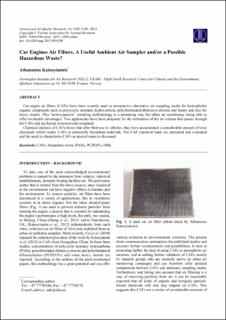| dc.contributor.author | Katsogiannis, Athanasios A. | |
| dc.date.accessioned | 2021-03-05T09:45:57Z | |
| dc.date.available | 2021-03-05T09:45:57Z | |
| dc.date.created | 2014-08-25T14:00:17Z | |
| dc.date.issued | 2014 | |
| dc.identifier.citation | Aerosol and Air Quality Research. 2014, 14, 1102-1105. | en_US |
| dc.identifier.issn | 1680-8584 | |
| dc.identifier.uri | https://hdl.handle.net/11250/2731787 | |
| dc.description.abstract | Car-engine air filters (CAFs) have been recently used as inexpensive alternative air sampling media for hydrophobic organic compounds such as polycyclic aromatic hydrocarbons, polychlorinated dibenzo-p-dioxins and furans and also for heavy metals. This “active-passive” sampling methodology is a promising way for urban air monitoring, being able to offer invaluable advantages. Two approaches have been proposed for the estimation of the air volume that passes through the CAFs and are herein reviewed and compared. Chemical analysis of CAFs shows that after their use in vehicles, they have accumulated a considerable amount of toxic chemicals which render CAFs as potentially hazardous materials. The CAF chemical loads are presented and evaluated and the need to characterize CAFs as special waste is discussed. | en_US |
| dc.language.iso | eng | en_US |
| dc.title | Car engines air filters. A useful ambient air sampler and/or a possible hazardous waste? | en_US |
| dc.type | Peer reviewed | en_US |
| dc.type | Journal article | en_US |
| dc.description.version | publishedVersion | en_US |
| dc.rights.holder | Copyright © Taiwan Association for Aerosol Research | en_US |
| dc.source.pagenumber | 1102-1105 | en_US |
| dc.source.volume | 14 | en_US |
| dc.source.journal | Aerosol and Air Quality Research | en_US |
| dc.source.issue | 4 | en_US |
| dc.identifier.doi | 10.4209/aaqr.2013.09.0290 | |
| dc.identifier.cristin | 1149172 | |
| cristin.ispublished | true | |
| cristin.fulltext | original | |
| cristin.qualitycode | 1 | |
